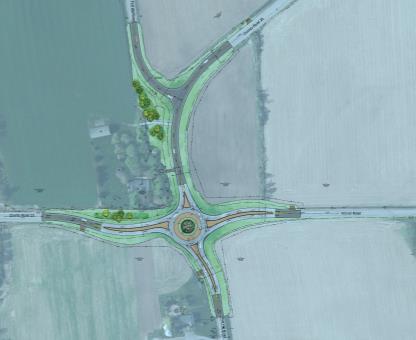A Case Study: The Wasteful Fort Hill Road Roundabout:
Old-Fashioned, Bottom-Up Representative Democracy instructs those in Government to listen to the People, not lord over them. As a Case Study in how local government should not be run, let me draw upon a personal example. No, it is not a lesson learned in Enfield. But just as likely it could be applied here, someday.

As my thumbnail biography states (see “Meet Bob”), I grew up on a farm in Phelps, Ontario County. My sister and I still own the old farmstead. About a half-mile from the farm there’s a lightly-traveled, yet complex five-way intersection; Fort Hill Road at McIvor Road, and County Road (CR) 23.
North-south Fort Hill Road intersects with McIvor on the east and CR 23 on the west. The eastern leg of CR 23 bends into Fort Hill at a stop sign just north of this four-way crossroads. Since I was a boy, Fort Hill Road traffic has always stopped to give east-west cars the right-of-way. Got the picture?
But sometimes Fort Hill Road traffic doesn’t stop. Collisions occur all too often, say Ontario County highway planners. The County has claimed that the accident rate is seven times the State average for an intersection of its sort. Even though we’re talking two farm-to-market roads here, not busy thoroughfares, County highway bosses insisted on the Cadillac of solutions, namely a multi-million dollar traffic circle, their much-heralded “Modern Roundabout.”
Before we go further, consider Roundabouts in general. I’d maintain they’re an acquired taste, kind of like spicy wings or the Opera. You either like ‘em or you don’t. I feel I’m taking my life (and my four fenders) in my own hands every time I round that circle on Albany Street at Old Elmira Road. You, too? (And the vision-obstructing foliage planted on the island doesn’t help, either.) Roundabouts can be free-for-alls. Anyway…
The common-sense solution at Fort Hill was so simple; it’s a no-brainer. Just make the intersection a four-way stop. Everyone waits his turn. If one driver ignores the signage, the motorist at right-angles has already stopped and can defensively take notice. For good measure, why not put some of those flashing solar-powered red L.E.D lights around the stop signs, just to grab drivers’ attention. Quick, effective, and cheap.
Oh, no; quick and cheap is too simple. “The multi-way stop alternative was dismissed from further consideration,” tersely stated the County in a 62-page, Appendix-embellished, taxpayer-funded consultant’s report. Every conceivable, overreaching excuse was raised to reject two simple Stop signs. Fuel might be wasted; rear-enders could occur; and those east-west drivers might waste a precious (though minuscule) two-seconds each. The overriding message: To you, the common critic: Go away. We know best!

Why the Roundabout obsession? You see, the County’s traffic engineer bragged that he’d gone to what I’ll call Roundabout School; some professional conference that had indoctrinated him in the beauty, utility and saving grace of traffic circles, even on country roads. Ignore the cost. Savor the splendor. Look how the driver glides around through traffic effortlessly. Affectionately hum that 1972 vintage oldie by Yes as you yield and circle. Roundabouts: How elegant. Put one here, one there, one everywhere!
Reality check: Roundabouts are expensive; very expensive. When the County held its (presumably legally-mandated) “Open House” with neighbors in March 2018, the projected cost was pegged at $2.5 Million. By the date bids were let in May 2019, the price tag had jumped to $3.2 Million. All that expense for an unnecessary Cadillac when a VW Bug would have sufficed.
But of course, to challenge the experts is to challenge the King. At the Open House, it became all-too-evident to me that the Modern Roundabout was a foregone conclusion, a decision baked-in-the-cake by those anointed with bureaucratic authority. About two dozen neighbors turned out. Many voiced objections. Not one soul supported the County’s idea. It didn’t matter.
Farmers complained about condemnation of their land. Some raised safety and environmental concerns. My sister and I tendered a 10-page critique. It all fell on deaf ears. The project proceeded. The objections were tossed aside. The Board of Supervisors awarded the cost-inflated bids this past May without any recorded opposition or debate. Roundabout construction commenced in late-June.
Said farmer Kenneth Trammel at the Open House, “Are you going to put [our comments] in a closet and do what you want?”
Responded the County’s engineer, “We’re taking your input into consideration, but we believe in it,” namely, the Roundabout, the product of their elitist obsession.
Did Ontario County ever give a tinker’s damn about Trammel’s criticism or mine? I find no evidence on the County’s website that it ever did. Are you surprised?

Phelps residents are not quite like us in Enfield or Tompkins County. They’re not as trained in activism. I wish they were. Anyone with a lick of common sense should have gotten up in arms about the wastefulness as well as with the outright arrogance among those in the Governing Class who profess to know far more than do the rest of us. Shame on us for letting them act as they do. And shame on a system that enables this self-anointed autocracy.
Sometimes, common sense is our best teacher. Forget the propaganda promulgated at Roundabout School. Listen to the people. The people, the voters, are the bosses, not the other way around.
There. A lesson in Democracy… and in fiscal irresponsibility. Let’s apply this lesson in Enfield.
Bob Lynch
Note: Ontario County’s February 2018 Draft Design Report for the Roundabout can be read at https://www.co.ontario.ny.us/DocumentCenter/View/13038/Draft-Design-Report?bidId= Pour a cup of coffee. The report with Appendices, numbers 399 pages. The County website fails to report any follow-up evaluation of public comments or post-comment conclusions. Again, surprised?

